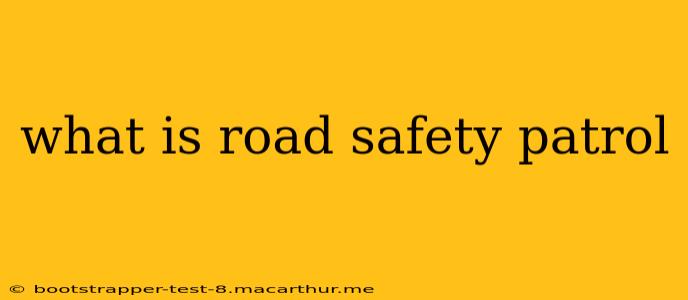Road Safety Patrols (RSP) are volunteer programs, typically run in schools, designed to improve safety for students walking or cycling to and from school. These programs empower students to take an active role in promoting safety within their communities, fostering a sense of responsibility and contributing to a safer environment for everyone. While the specifics can vary slightly from location to location, the core mission remains consistent: to reduce accidents and promote safe pedestrian and cyclist behavior.
What are the responsibilities of a Road Safety Patrol?
Road Safety Patrol members typically perform a variety of duties, all centered around enhancing road safety around the school. These responsibilities often include:
- Controlling pedestrian crossings: Patrollers help students safely cross streets, ensuring they follow traffic signals and look both ways before crossing. This often involves directing traffic at designated crossing points near the school.
- Enforcing school crossing rules: Patrollers remind students to walk, not run, in designated areas and to obey traffic signals and signs. They encourage safe practices and model good behavior.
- Educating students and drivers: Patrols promote safe walking and cycling habits among their peers and help raise awareness among drivers about school zones and the need to exercise caution.
- Reporting hazards: They identify and report any potential safety hazards, such as damaged sidewalks, poor visibility, or reckless driving, to school officials and relevant authorities.
- Maintaining order: In some cases, patrols might assist with maintaining order during arrival and dismissal times, keeping students from running or engaging in unsafe behavior.
What are the benefits of a Road Safety Patrol?
The benefits of RSP programs extend far beyond simply reducing accidents. They offer a wide range of advantages for both the individual students involved and the wider community:
- Increased student safety: The most significant benefit is the obvious reduction in accidents and injuries around the school.
- Development of leadership skills: Participating in the patrol provides students with opportunities to develop leadership, teamwork, and responsibility.
- Community involvement: It allows students to actively contribute to their community and make a positive impact.
- Improved awareness of road safety: Patrollers gain a deeper understanding of road safety rules and the importance of responsible behavior.
- Enhanced driver awareness: The presence of a patrol can serve as a reminder to drivers to slow down and be more cautious in school zones.
How do I join a Road Safety Patrol?
The process of joining a Road Safety Patrol varies depending on the school and location. Typically, students interested in joining will need to express their interest to school officials or teachers. There's often an application process and training involved, teaching students about road safety rules, communication skills, and appropriate patrol procedures.
Who is responsible for overseeing Road Safety Patrols?
Generally, school staff, such as teachers or administrators, are responsible for overseeing the Road Safety Patrol. They provide training, supervision, and guidance to the student patrollers, ensuring their safety and the effective operation of the program. Often, local police departments or transportation officials may also provide support and training.
What are the age requirements for Road Safety Patrols?
The age requirements for Road Safety Patrols typically vary based on school policies and local regulations. However, they usually involve older, more mature students who can demonstrate responsibility and a good understanding of road safety rules. This often means upper elementary or middle school students.
Are there any specific training requirements for Road Safety Patrol members?
Yes, most Road Safety Patrol programs include some form of training. This training generally covers:
- Road safety rules and regulations: Students learn about pedestrian and cyclist safety, traffic signals, and road signs.
- Communication skills: They learn how to effectively communicate with both students and drivers.
- Safe patrol procedures: They are taught how to safely and effectively direct traffic and manage crossings.
- Emergency procedures: Training often covers what to do in emergency situations.
By understanding the various aspects of Road Safety Patrols, communities can better appreciate the crucial role these programs play in creating safer environments for students and the wider community. The commitment of these young volunteers contributes significantly to improving road safety around schools.
